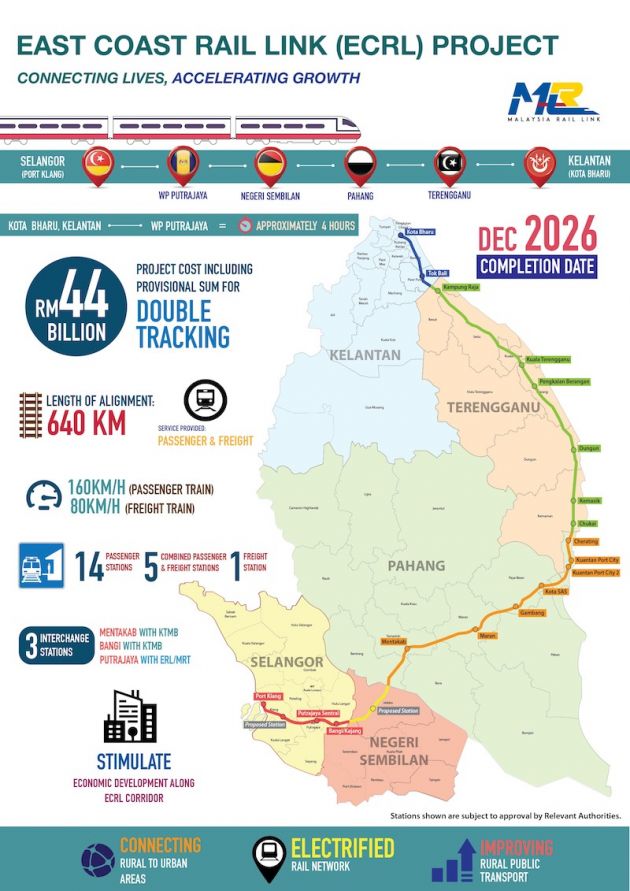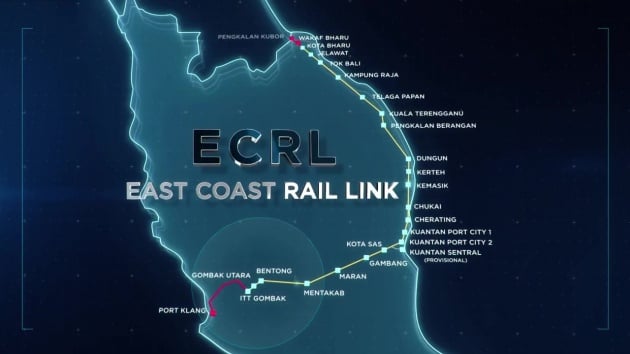It’s been awhile since we heard about the East Coast Rail Link (ECRL), and the latest news is that the 640 km mega project is expected to be operational as early as January 1, 2027. This was revealed by deputy finance minister Datuk Abdul Rahim Bakri, who said that construction is scheduled to be completed by the end of 2026.
The ECRL – which goes through Kelantan, Terengganu, Pahang, Negeri Sembilan, Selangor and Putrajaya – would be a catalyst for economic growth in the East Coast and the country as a whole in the next few decades, Abdul Rahim said, reported by Bernama.
“This project is also expected to boost trade between Malaysia and China. Being a China-funded project, we hope the country’s commodity exports, in particular oil, gas, palm oil, rubber and manufactured products, can penetrate the Chinese market more widely.
“When the Covid-19 pandemic ends, there will be an influx of Chinese tourists for sure, and the country’s tourism revenue will also increase,” he said in a statement after attending a briefing on the ECRL, which will use the standard gauge track instead of Malaysia’s existing three metre gauge double track.
The use of the standard gauge track – which as its name suggests, is the common modern rail standard – opens the path for faster trains, of up to 300 km/h if the operator desires. ECRL passenger trains will run at 160 km/h and goods trains will go at half that speed.
Some might remember the ECRL as being cancelled by the previous Pakatan Harapan government, as that was what happened in August 2018 soon after it came into power. However, after negotiations with China, the project was revived in April 2019 with a new cost of RM44 billion, a reduction of RM21.5 billion or 32.8%. The cost per km figure became RM68.7 million, down from RM95.5 million, the PH government said.
With the cost reduction came a realignment. The new and shorter 640 km route with 20 stations does not bore through the Klang Gates Quartz Ridge in Gombak. From Mentakab in Pahang, it goes south into Negeri Sembilan (a new addition, making it five states plus Putrajaya) before heading to Port Klang via Bangi/Kajang and Putrajaya. The original route (688 km, 26 stops) was a more direct one through the main range via Bentong and Gombak, after Mentakab.
With the new ECRL route, Putrajaya is set to be a rail hub. This will be even more so if the KL-Singapore High Speed Rail (HSR) project is successfully renegotiated and comes back to life – the original HSR plan had Putrajaya as one of the stops.
Currently, the federal administrative capital is connected to the KLIA Express Rail Link (ERL), while the MRT Putrajaya Line (formerly known as the MRT Sungai Buloh-Serdang-Putrajaya SSP Line) is under construction. The original ECRL route’s connection to the Klang Valley rail network was with the LRT at Gombak.
Looking to sell your car? Sell it with Carro.













Good to hear that progress is back on track but hopefully it can return back to its original alignment as mentioned by Dr Wee.
Well, there goes a decade of my life.
Take note Paultan writers, the new govt is planning to revert to the old planning route, saying that it’s research shows going through negeri sembilan has lower prospect and revenue. The cost may go up.again, but that’s OK with China.
Spend more but we reap more, I don’t mind that. As what Dr Wee said, changing the project scope didn’t save us with lower pricing only with less economic potential later on. Might as well bite the bullet and get it back on the right track towards the right purpose of ECRL; as the last mile for Belt & Silk road effectively bypassing S’pore.
I’m aware of the technical benefits of the standard gauge track. But does it make sense in Malaysia?
As far as I know, all countries between Malaysia and China use the metre gauge track (which is cheaper to build). So how shall a standard gauge track in Malaysia “boost trade between Malaysia and China”, if Thailand etc. still use the metre gauge?
Std gauge allows for higher speed trainsets.
ECRL should go back to its original allignment because to make it viable & sustainable, major transportation network such as ECRL cannot bypass capital city KL as it is the main existing transportation hub of the country.